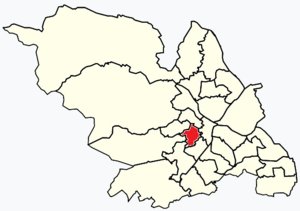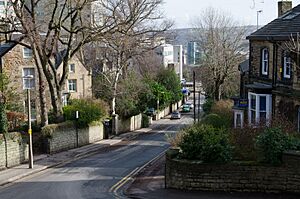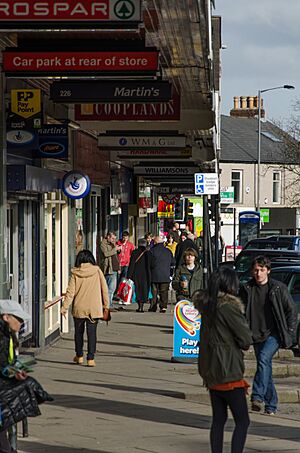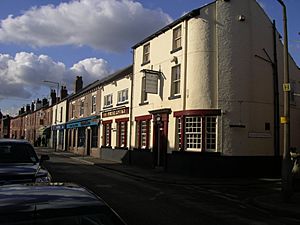Broomhill and Sharrow Vale facts for kids
Quick facts for kids Broomhill and Sharrow Vale |
|
|---|---|
 Shown within Sheffield |
|
| Population | 16,966 |
| Metropolitan borough | |
| Metropolitan county | |
| Region | |
| Country | England |
| Sovereign state | United Kingdom |
| EU Parliament | Yorkshire and the Humber |
| UK Parliament |
|
| Councillors | Brian Holmshaw (Green Party) Kaltum Rivers (Green) Angela Argenzio (Green) |
Broomhill and Sharrow Vale is an area in Sheffield, England. It includes several smaller areas like Broomhill, Broomhall, Crookesmoor, Endcliffe, Sharrow Vale, and Tapton Hill. This area is one of the 28 electoral wards in the City of Sheffield.
The ward was created in 2015. It combines parts of older wards called Broomhill, Central, and Nether Edge. You can find it in the western part of Sheffield. In 2011, about 16,966 people lived here in 5,708 homes. The area covers about 2.7 square kilometers. Broomhill & Sharrow Vale is also part of the Sheffield Central area for Parliament.
Contents
History of Broomhill and Sharrow Vale
A long time ago, much of what is now Broomhill was a racecourse. It was called the Crookesmoor Racecourse and was used from 1711 to 1781. The races stopped when the common lands were divided up.
There were only a few houses in this area at first. Some were built on common land. There was also a group of small cottages near the Sheffield Botanical Gardens. One of these was an inn called "The Ball in the Tree," which was taken down in 1870.
The name "Broomhill" comes from a house built in 1792. William Newbould built it and called it "Broomhill." It was the first house on a hill above an area called Broomhall.
More large houses were built over the next 30 years. But the area really started to grow in 1821. This was when a new main road, a turnpike road, opened towards Glossop. Smaller houses and even the first back-to-back homes were built along this road.
By the early 1830s, Broomhill had five pubs and a few shops. Many famous people from the steel and cutlery industries lived here. Also, many founders of city stores, brewers, lawyers, and doctors lived or passed through Broomhill. There were also many skilled workers and small shopkeepers. They provided services for the larger houses.
The shopping area in Broomhill was very good. It became even more important during World War II. Several shops from the city center moved to Broomhill after their buildings were bombed. One famous store was John Walsh Ltd.
The area even inspired a famous poet, John Betjeman. He wrote a poem about Broomhill called 'An Edwardian Sunday, Broomhill, Sheffield'. His poem talks about the big stone houses, the steel industry, and the hilly landscape.
Many student homes for the University of Sheffield are in this area. There are also many private homes where students live. One building, "Fairholme," is now a student residence. During World War II, it was used for research by the Sorby Research Institute. The main shopping street on Fulwood Road is often called "Broomhill." It has many takeaways, pubs, a supermarket, and local shops.
Districts of Broomhill and Sharrow Vale Ward
The Broomhill and Sharrow Vale ward is made up of several interesting districts. Each one has its own unique history and features.
Broomhill
Broomhill is a western part of Sheffield. Most of it was built in the 1800s. Important buildings include Broomhill Church, The Mount, and King Edward VII School. The last two were designed by William Flockton.
This area is west of the main University of Sheffield campus. Many students live here. In 2003, it was named one of the wealthiest areas outside London.
The center of Broomhill is a special "conservation area." This means its historic character is protected. Hospitals and the Sheffield Botanical Gardens are nearby. In 1981, a criminal named Peter Sutcliffe was arrested on Melbourne Avenue here. The 2011 Census showed that 1,943 people lived in Broomhill.
Broomhall
Broomhall is a district in Sheffield, west of the city center. It sits on land that once belonged to Broom Hall. This historic mansion still stands today. It dates back to at least the 1400s.
In 1791, a group of people protested against a new land law. They attacked and set fire to Broom Hall.
In 1973, a designer named David Mellor started making cutlery here. He fixed up the old Broom Hall to use as his factory. The building was in bad shape before he renovated it. He also changed how cutlery was made. Workers used to do only one task. But David Mellor had them switch tasks. This made their jobs more interesting.
The Broomhall Park Association was started in 1967. Residents wanted to protect the special feel of Broomhall. They wanted to make sure it stayed a nice place to live. Broomhall is close to the University of Sheffield. It is a diverse area with large houses and student homes. It also has good transport links to other parts of Sheffield.
Crookesmoor
Crookesmoor is just north of the University of Sheffield's main campus. It has the University's Crookesmoor library and a sports center. It is east of Crookes and south of Walkley. This is a residential area with many terraced houses. Many students live here.
Crookesmoor is home to Crookes Valley Park. This park has a lake, which was once part of a chain of reservoirs. A racecourse was in Crookesmoor from 1711 to 1781. It had a large grandstand near Fulwood Road.
Endcliffe
Endcliffe is southwest of Broomhill. It is a wealthy residential area. It includes Birkdale School, which is a private school. Part of the "Endcliffe Student Village" is also here. This village has new flats and older student halls owned by the University of Sheffield.
The area also has a large mansion called Endcliffe Hall. It has 36 rooms and was built in the 1860s. It was built for a steel boss named John Brown.
Sharrow Vale
Sharrow Vale is in the southwestern part of Sheffield. It is located near the Porter Brook and Ecclesall Road. Hunter's Bar is a key intersection here. It used to be a place where people paid a toll to use the road in the 1700s. The old toll house is gone, but you can still see the toll gate.
To the north of Sharrow Vale are the Sheffield Botanical Gardens. The historic Sheffield General Cemetery is to the east. To the west is Endcliffe Park. This park is the first in a series of parks that follow the Porter Brook out of Sheffield.
Tapton Hill
Tapton Hill is a district within the suburb of Crosspool. The Tapton Hill transmitting station and Tapton Hall are located in this area.




